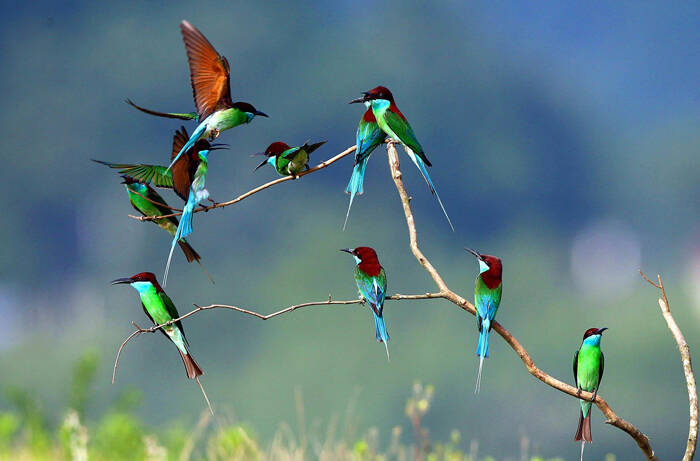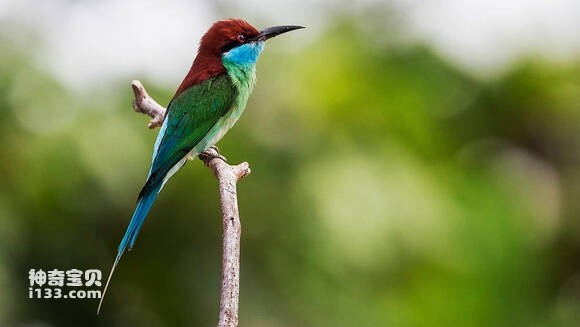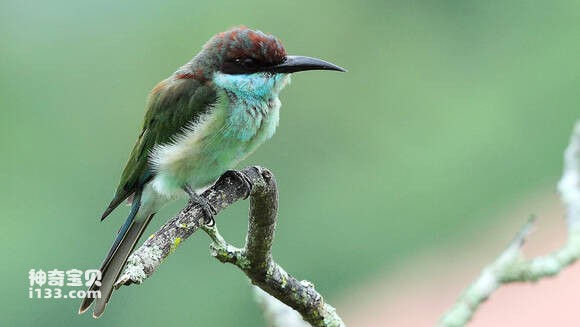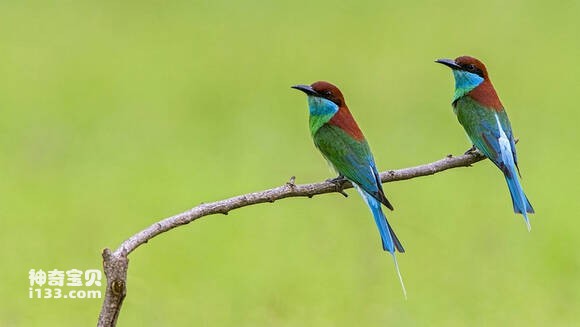Merops viridis
IUCN
LCBasic Information
Scientific classification
- name:Merops viridis
- Scientific Name:Red-headed hummingbird,Merops viridis,Blue-throated bee-eater
- Outline:Climbing birds
- Family:order family genus
Vital signs
- length:26-27cm
- Weight:32-35g
- lifetime:No verification information
Feature
The top of the head and upper back are chestnut red or chocolate, the chin and throat are blue, and the rest of the lower body and wings are green
Distribution and Habitat
Origin: Brunei, Cambodia, China, Indonesia, Laos, Malaysia, Philippines, Singapore, Thailand, Vietnam.
In China, it is mainly distributed in the southern regions of southeastern Yunnan (resident bird), southern Guangxi, Guangdong, Hainan Island (resident bird), Fujian, Taiwan (stray bird) and Hong Kong (stray bird), sometimes extending northward to Hunan, Jiangxi, and even to southern Henan.
It inhabits open places such as sparse forests, shrubs, and grass slopes at the edge of forests, and also appears in farmlands, coasts, river valleys and orchards. It especially likes open fields and woodlands in low-lying areas near the sea.
Appearance
The forehead, top of the head, pillow, back neck and upper back are dark maroon, the lower back is blue-green, the waist is sky blue, the tail is blue, the central tail feathers are extended and protrude about 65 mm; the shoulders and wings are green, the inner flight feathers are blue, and the eye stripes Black, widening behind the eyes. The chin, throat and sides of the neck are blue, the chest and upper abdomen are green, the abdomen is light green, and the undertail coverts are light blue.
Young birds are like adult birds, but the head, pillow and upper back are dark green, and the central tail feathers are not extended.
The iris is red, and the mouth and feet are black.
Size measurements: body weight ♂35g, ♀32g; body length ♂273mm, ♀267mm; bill peak ♂38.5mm, ♀35mm; wings ♂113mm, ♀109mm; tail ♂130mm, ♀123mm; Tarsometatarsus ♂11 mm, ♀12.5 mm. (Note: ♂ male; ♀ female)
Details
Blue-throated bee-eater, also known as Blue-throated bee-eater, has 2 subspecies.

Blue-throated bee-eaters often move alone or in small groups, often flying in the sky to find food, and often resting on trees or wires.

The migration time of the blue-throated bee-eater is from April to May in spring and from September to October in autumn. It mainly feeds on various bees and also eats other insects. It likes to stay on the perch and wait for passing insects; occasionally pick up insects from the water or the ground. Call: It makes a rapid trill of kerik-kerik-kerik when flying.

The breeding season of the blue-throated bee-eater is from May to July. During the breeding season, the birds gather in sandy areas and build nests in caves. Each nest lays 4 eggs, and the size of the eggs is 21.5~24.6 mm × 19~20.5 mm.

The global population of blue-throated bee-eaters has not been quantified, but it is widely distributed in its native habitat and is a common species (del Hoyoet al. 2001). There are less than 10,000 breeding pairs in China (Brazil 2009), and the number is relatively abundant in some local areas.

Listed in the IUCN Red List: Least Concern (LC), assessed in 2014.
Listed in the "National List of Terrestrial Wildlife with Important Economic and Scientific Research Value" issued by the State Forestry Administration of China on August 1, 2000. (Note: Item 273 Blue-throated Tiger)
Listed in the second level of China's "National Key Protected Wildlife List" (February 5, 2021).
Protect wild animals and eliminate game.
Maintaining ecological balance is everyone's responsibility!








